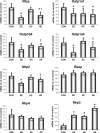Protective effect of heme oxygenase induction in ethinylestradiol-induced cholestasis
- PMID: 25683492
- PMCID: PMC4420596
- DOI: 10.1111/jcmm.12401
Protective effect of heme oxygenase induction in ethinylestradiol-induced cholestasis
Abstract
Estrogen-induced cholestasis is characterized by impaired hepatic uptake and biliary bile acids secretion because of changes in hepatocyte transporter expression. The induction of heme oxygenase-1 (HMOX1), the inducible isozyme in heme catabolism, is mediated via the Bach1/Nrf2 pathway, and protects livers from toxic, oxidative and inflammatory insults. However, its role in cholestasis remains unknown. Here, we investigated the effects of HMOX1 induction by heme on ethinylestradiol-induced cholestasis and possible underlying mechanisms. Wistar rats were given ethinylestradiol (5 mg/kg s.c.) for 5 days. HMOX1 was induced by heme (15 μmol/kg i.p.) 24 hrs prior to ethinylestradiol. Serum cholestatic markers, hepatocyte and renal membrane transporter expression, and biliary and urinary bile acids excretion were quantified. Ethinylestradiol significantly increased cholestatic markers (P ≤ 0.01), decreased biliary bile acid excretion (39%, P = 0.01), down-regulated hepatocyte transporters (Ntcp/Oatp1b2/Oatp1a4/Mrp2, P ≤ 0.05), and up-regulated Mrp3 (348%, P ≤ 0.05). Heme pre-treatment normalized cholestatic markers, increased biliary bile acid excretion (167%, P ≤ 0.05) and up-regulated hepatocyte transporter expression. Moreover, heme induced Mrp3 expression in control (319%, P ≤ 0.05) and ethinylestradiol-treated rats (512%, P ≤ 0.05). In primary rat hepatocytes, Nrf2 silencing completely abolished heme-induced Mrp3 expression. Additionally, heme significantly increased urinary bile acid clearance via up-regulation (Mrp2/Mrp4) or down-regulation (Mrp3) of renal transporters (P ≤ 0.05). We conclude that HMOX1 induction by heme increases hepatocyte transporter expression, subsequently stimulating bile flow in cholestasis. Also, heme stimulates hepatic Mrp3 expression via a Nrf2-dependent mechanism. Bile acids transported by Mrp3 to the plasma are highly cleared into the urine, resulting in normal plasma bile acid levels. Thus, HMOX1 induction may be a potential therapeutic strategy for the treatment of ethinylestradiol-induced cholestasis.
Keywords: 17α- ethinylestradiol; bile acids; heme; multidrug resistance-associated protein 3; nuclear factor erythroid-2-related factor-2.
© 2015 The Authors. Journal of Cellular and Molecular Medicine published by John Wiley & Sons Ltd and Foundation for Cellular and Molecular Medicine.
Figures





References
-
- Schreiber AJ, Simon FR. Estrogen-induced cholestasis: clues to pathogenesis and treatment. Hepatology. 1983;3:607–13. - PubMed
-
- Lammert F, Marschall HU, Glantz A, et al. Intrahepatic cholestasis of pregnancy: molecular pathogenesis, diagnosis and management. J Hepatol. 2000;33:1012–21. - PubMed
-
- Simon FR, Fortune J, Iwahashi M, et al. Ethinyl estradiol cholestasis involves alterations in expression of liver sinusoidal transporters. Am J Physiol. 1996;271:G1043–52. - PubMed
-
- Bouchard G, Yousef IM, Tuchweber B. Decreased biliary glutathione content is responsible for the decline in bile salt-independent flow induced by ethinyl estradiol in rats. Toxicol Lett. 1994;74:221–33. - PubMed
Publication types
MeSH terms
Substances
LinkOut - more resources
Full Text Sources
Other Literature Sources
Research Materials
Miscellaneous

